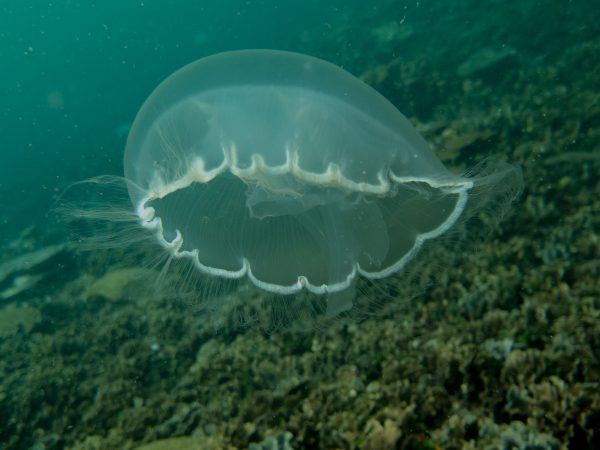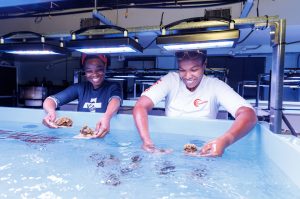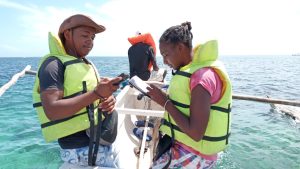Even though we can’t celebrate Halloween as we used to in the era of COVID-19, jellyfish costumes are among the most popular and beautiful. In honour of October 31, let’s talk a little more about invertebrates in the Class Medusozoa, also known as jellyfish!These animals have been living in the world’s oceans for more than 700 million years. They are very simple morphologically: their bodies are mostly water (98%) with a gelatinous tissue layer, a rudimentary nervous system and thousands of stinging cells in their tentacles used to capture pray. Despite their simple appearance, some species have up to 24 eyes that they use to “see” their environment.

Toxicity among jellyfish varies widely. Most of the toxins they hold within their stinging cells can produce pain in humans, and some can kill a human in minutes. Among the most poisonous are the tiny box jellyfish – mostly found around Australian waters – which can carry venom capable of killing 60 humans.Jellyfish size ranges from tiny animals with bell disks no more than 0.5 mm in diameter, to huge animals with bell disks of 2 m (Nomura’s jellyfish, Nemopilema nomurai). Some even exhibit tentacles measuring up to 37 m (Lion’s mane jellyfish, Cyanea capillata)!

JELLYFISH NUMBERS APPEAR TO BE INCREASING
Did you know that a group of jellyfish are called a “smack”? In some regions, jellyfish are proliferating even during seasons they usually weren’t around. There could be a number of reasons for these non-expected peaks, however overfishing and pollution seems to be the main causes. Few animals feed on jellyfish due to their low nutrient content and high number of stinging cells filled with toxins, some of these animals are sea turtles, red tuna and swordfish, all of them are currently endangered species due to overfishing. Coastal water nutrient enrichment, also known as pollution, is resulting in an increase of plankton which is the main food for jellyfish. In addition, some studies have shown that warmer temperatures and ocean acidification are beneficial for jellyfish reproduction, increasing the number of offspring. Therefore, with global change jellyfish peaks can be the new normal even in sites never been seen before. As a response, in some countries people are starting to explore ways to eat them; would you try them?

JELLYFISH IN THE BAHAMAS
In The Bahamas, jellyfish can be found in different marine ecosystems and there are few species that are seasonal. In muddy areas like seagrasses and mangroves, the upside-down jellyfish (Cassiopea xamachana) is very common, as is the moon jelly (Aurelia aurita) in coastal areas swimming in the first 20 m depth. Both have stinging cells that can cause pain or adverse reaction in humans. The upside-down jellyfish can even deliver mucus containing free stinging cells that sting in the water!
Photos: Valeria Pizarro & Natalia Hurtado




New Reef Rescue Sites Take Root in Barbados and Grenada
Barbados Blue and Eco Dive Grenada dive shop owners Andre Miller and Christine Finney (Credit: Eco Dive) Reef Rescue Network Expands to Barbados and Grenada The Perry Institute for Marine

The Bahamas Just Opened a Coral Gene Bank—Here’s Why It Matters
The nation’s first coral gene bank will preserve, propagate and replant coral to reverse devastation from rising ocean temperatures and a rapidly spreading disease Video courtesy of Atlantis Paradise Island.

This Is What Conservation Leadership Looks Like
From Interns to Leaders: How PIMS is Powering the Next Generation of Ocean Advocates Taylor photographs coral microfragments in the ocean nursery, helping monitor their fusion into healthy, resilient colonies

When Ocean Forests Turn Toxic
New study in Science connects chemical “turf wars” in Maine’s kelp forests to the struggles of Caribbean coral reefs — and points to what we can do next Lead author,

Who’s Really in Charge? Unpacking the Power Struggles Behind Madagascar’s Marine Protected Areas
Researchers head out to monitor Marine Protected Area boundaries—where science meets the sea, and local stewardship takes the lead. The Illusion of Protection From dazzling coral reefs to centuries-old traditions,

PIMS and Volunteers Step Up as Legal Battle Leaves Barge Grinding Reef in Fowl Cays National Park
Worn out but undefeated, the cleanup crew rallies around their paddleboard “workbench” in front of the stranded tug and barge—a snapshot of community grit after hours of underwater heavy‑lifting. Photo



